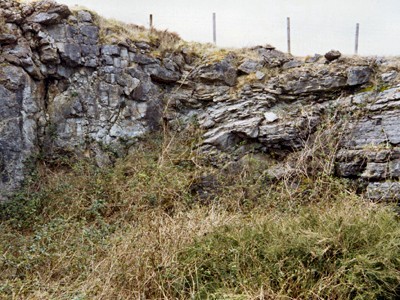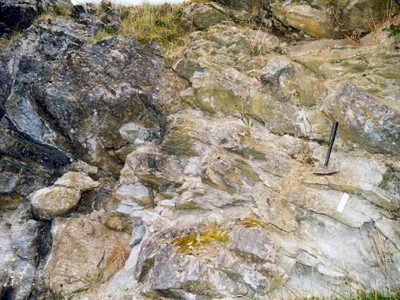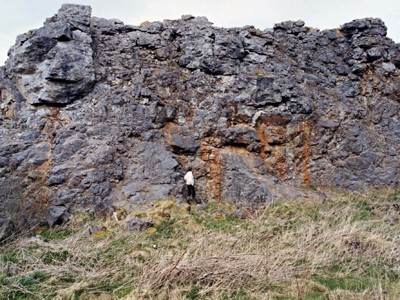Earth Science Conservation Review
| Magherameena Quarry, Belleek | Fermanagh |

| Site Type: | Quarry (disused) |
| Site Status: | ASSI |
| Council area: | Fermanagh District Council |
| Grid Reference: | G980597 |
| Google maps: | 54.4862,-8.03083 |
| Rocks | |
|---|---|
| Rock Age: | Carboniferous (Arundian, Chadian, Visean) |
| Rock Name: | Ballyshannon Limestone Formation, Magherameena Limestone Member, Tyrone Group |
| Rock Type: | Crinoidal limestone, Limestone |
| Interest | |
| Fossil Groups: | Brachiopod, Coral, Crinoid, Foraminifera, Polyzoan |
| Other interest: | Marine sediments |
Summary of site:
This is one of the finest, if not the finest, exposure through a Waulsortian mud mound, to be seen anywhere in Northern Ireland and has the additional distinction of being 80 km north of what was previously considered to be the limit of Waulsortian mound development and 30 km west of the only other mound of this kind in the province. It is believed to be the most northerly Waulsortian development in Europe. Its relationship with its associated deposits is also clear.
In this quarry a lens shaped mound of very fine-grained lime mud, around 12 m high, can be seen enclosed within bedded limestones and silty shales inclined almost 20 degrees to the south. The bedded limestones are full of crinoid debris (crinoids are relatives of the starfish and sea urchins normally attached to the sea bed by a long 'stem') with a little lime mud in the interstices and contains a limited fossil fauna of bryozoa (moss animals) with small numbers of brachiopods (lamp shells) and horn corals. Under the microscope foraminifera can be seen, of limited variety (5 species) and lime-fixing algae (simple, primitive plants).
Where the mound thins out on its flanks into the stratified rocks, the beds are crumpled and disrupted and littered with angular and twisted lumps of limestone in a mud matrix. The beds on top of the mound are crinoidal limestones and mudstones and do not have a normal contact with its summit.
The mound itself consists of finest lime mud, grey to fawn-grey in colour, and without bedding. Small, often interlinking, cavities in the mud are filled with layered oozes often with the final cavity obliterated with calcite. Lace-like cones of fenestrellid bryozoa appear to create a loose framework but are also coated in mud. Brachiopods specialised to live on the mounds are common but species have long age ranges and are not useful for dating the time of formation.
Exactly how these mounds were formed is something of a mystery. Fine mud standing on the sea bed is unlikely to form a slope of more than a degree or two so obviously there was some kind of binding framework involved. While the fenestrellid bryozoa would appear to provide it here, they are not ubiquitous in mud mounds and have been discounted. A clue may lie in the cavities that dot the mud but what occupied or created them is unknown. The mounds appear to originate below the level of light penetration into the sea and grow up into the light (photic) zone.
The term 'Waulsortian' can not be generally used to describe mud mounds. It was derived from an area of mounds at Waulsort in Belgium and is restricted to mounds formed in the late Tournaisian and early Visean of the Carboniferous period. Spores isolated from rocks near the quarry suggest an early Visean age meaning that this superb example of a mound qualifies for the classic application of the term.
The mound developed on the outer edge of a carbonate shoreline shelf where it steepened before pitching into deeper water. This was a tropical sea on the margin of a continent drifting imperceptibly northwards around 350 million years ago.
In this quarry a lens shaped mound of very fine-grained lime mud, around 12 m high, can be seen enclosed within bedded limestones and silty shales inclined almost 20 degrees to the south. The bedded limestones are full of crinoid debris (crinoids are relatives of the starfish and sea urchins normally attached to the sea bed by a long 'stem') with a little lime mud in the interstices and contains a limited fossil fauna of bryozoa (moss animals) with small numbers of brachiopods (lamp shells) and horn corals. Under the microscope foraminifera can be seen, of limited variety (5 species) and lime-fixing algae (simple, primitive plants).
Where the mound thins out on its flanks into the stratified rocks, the beds are crumpled and disrupted and littered with angular and twisted lumps of limestone in a mud matrix. The beds on top of the mound are crinoidal limestones and mudstones and do not have a normal contact with its summit.
The mound itself consists of finest lime mud, grey to fawn-grey in colour, and without bedding. Small, often interlinking, cavities in the mud are filled with layered oozes often with the final cavity obliterated with calcite. Lace-like cones of fenestrellid bryozoa appear to create a loose framework but are also coated in mud. Brachiopods specialised to live on the mounds are common but species have long age ranges and are not useful for dating the time of formation.
Exactly how these mounds were formed is something of a mystery. Fine mud standing on the sea bed is unlikely to form a slope of more than a degree or two so obviously there was some kind of binding framework involved. While the fenestrellid bryozoa would appear to provide it here, they are not ubiquitous in mud mounds and have been discounted. A clue may lie in the cavities that dot the mud but what occupied or created them is unknown. The mounds appear to originate below the level of light penetration into the sea and grow up into the light (photic) zone.
The term 'Waulsortian' can not be generally used to describe mud mounds. It was derived from an area of mounds at Waulsort in Belgium and is restricted to mounds formed in the late Tournaisian and early Visean of the Carboniferous period. Spores isolated from rocks near the quarry suggest an early Visean age meaning that this superb example of a mound qualifies for the classic application of the term.
The mound developed on the outer edge of a carbonate shoreline shelf where it steepened before pitching into deeper water. This was a tropical sea on the margin of a continent drifting imperceptibly northwards around 350 million years ago.
| Enlander, I., Dempster, M. & Doughty, P., 2025. Magherameena Quarry, Belleek, County Fermanagh, site summary. [In] Earth Science Conservation Review. https://www.habitas.org.uk/escr/summary.php?item=224. Accessed on 2025-04-03 |
| Previous Site | Next Site |

